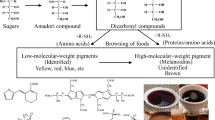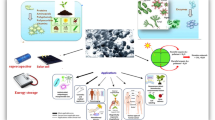Abstract
Photooxidation of sulfur-containing amino acids and derivatives readily occurs upon visible-light irradiation in the presence of flavins. The sulfur moiety seems pivotal for interaction, as was determined from kinetic analyses using laser flash photolysis spectroscopy. After photooxidation, the resulting radical intermediates were characterized by addition to a spin trap, followed by electron paramagnetic resonance spectroscopy and evaluation of the coupling constants. The presence of the proposed radical intermediates was strongly supported by the identification of the reaction products using mass spectrometry. Accordingly, feasible degradation pathways for various sulfur-containing amino acids and derivatives were proposed. It was finally proven that flavin-induced photoproduction of sulfhydryl radicals and recombination with a 3-methylbut-2-enyl radical, derived from the photodegradation of hop-derived isohumulones, are decisive in the formation of beer lightstruck flavor.
Similar content being viewed by others
References
C. Lintner, in Lehrbuch der Bierbrauerei, Verlag Vieweg und Sohn, Braunschweig, Germany, 1875, p. 343.
F. Gunst, M. Verzele, On the sunstruck flavour of beer, J. Inst. Brew., 1978, 84, 291–292.
A. J. Irwin, L. Bordeleau, R. L. Barker, Model studies and flavor threshold determination of 3-methyl-2-butene-1-thiol in beer, J. Am. Soc. Brew. Chem., 1993, 51, 1–3.
D. De Keukeleire, Interplay of photochemistry and beer: How lightstruck flavor is formed and how it can be prevented, The Spectrum, 2001, 1, 1–10.
Y. Kuroiwa, H. Hashimoto, Studies on hops with reference to their role in the evolution of sunstruck flavor of beer, Rep. Res. Lab Kirin Brew. Co. Ltd., 1961, 4, 35–40.
Y. Kuroiwa, N. Hashimoto, H. Hashimoto, E. Kobuko, K. Nakagawa, Factors essential for the evolution of sunstruck flavour, Proc. Am. Soc. Brew. Chem., 1963, 181–193.
W. J. Simpson, Studies on the sensitivity of lactic-acid bacteria to hop bitter acids, J. Inst. Brew., 1993, 5, 405–411.
D. C. Clarck, P. J. Wilde, D. R. Wilson, The effect of pre-isomerized hop extract on the properties of model protein stabilized foams, J. Inst. Brew., 1991, 3, 169–172.
C. S. Burns, A. Heyerick, D. De Keukeleire, M. D. E. Forbes, Mechanism for formation of the lightstruck flavor in beer revealed by time-resolved electron paramagnetic resonance, Chem.–Eur. J., 2001, 7, 4553–4561.
A. Heyerick, Y. Zhao, P. Sandra, K. Huvaere, F. Roelens, D. De Keukeleire, Photolysis of hop-derived trans-iso-α-acids and trans-tetrahydroiso-α-acids: product identification in relation to the lightstruck flavour of beer, Photochem. Photobiol. Sci., 2003, 2, 306–314.
M. G. Duyvis, R. Hilhorst, C. Laane, D. J. Evans, D. J. M. Schmedding, Role of riboflavin in beer flavor instability: determination of levels of riboflavin and its origin in beer by fluorometric apoprotein titration, J. Agric. Food Chem., 2002, 6, 1548–1552.
M. S. Grodowski, B. Veyret, K. Weiss, Photochemistry of flavins. II. Photophysical, properties of alloxazines and isoalloxazines, Photochem. Photobiol., 1977, 26, 341–352.
P. F. Heelis, B. J. Parsons, G. O. Phillips, J. F. McKellar, A laser flash-photolysis study of nature of flavin mononucleotide triplet-states and reactions of neutral form with amino acids, Photochem. Photobiol., 1978, 28, 169–173.
K. Kino, I. Saito, H. Sugiyama, Product analysis of GG-specific photooxidation of DNA via electron transfer: 2-aminoimidazolone as a major guanine oxidation product, J. Am. Chem. Soc., 1998, 120, 7373–7374.
C.-Y. Lu, S.-D. Yao, N.-Y. Lin, Photooxidation of 2′-deoxyguanosine 5′-monophosphate (dGMP) by flavin adenine dinucleotide (FAD) via electron transfer: a laser photolysis study, Chem. Phys. Lett., 2000, 330, 389–396.
C.-Y. Lu, W.-Z. Lin, W.-F. Wang, Z.-H. Han, S.-D. Yao, N.-Y. Lin, Riboflavin (VB2) photosensitized oxidation of 2′-deoxyguanosine-5′-monophosphate (dGMP) in aqueous solution: a transient intermediates study, Phys. Chem. Chem. Phys., 2000, 2, 329–334.
C.-Y. Lu, Y.-Y. Liu, Electron transfer oxidation of tryptophan and tyrosine by triplet states and oxidized radicals of flavin sensitizers: a laser flash photolysis study, Biochim. Biophys. Acta, 2002, 1571, 71–76.
D. R. Cardoso, P. Homem-De-Mello, K. Olsen, A. B. F. Da Silva, D. W. Franco, L. H. Skibsted, Deactivation of triplet-excited riboflavin by purine derivatives: Important role of uric acid in light-induced oxidation of milk sensitized by riboflavin, J. Agric. Food Chem., 2005, 9, 3679–3684.
D. R. Cardoso, D. W. Franco, K. Olsen, M. L. Andersen, L. H. Skibsted, Reactivity of bovine whey proteins, peptides, and amino acids toward triplet riboflavin as studied by laser flash photolysis, J. Agric. Food Chem., 2004, 21, 6602–6606.
K. Huvaere, K. Olsen, M. L. Andersen, L. H. Skibsted, A. Heyerick, D. De Keukeleire, Riboflavin-sensitized photooxidation of isohumulones and derivatives, Photochem. Photobiol. Sci., 2004, 34, 337–340.
K. Huvaere, B. Sinnaeve, J. Van Bocxlaer, D. De Keukeleire, Photooxidative degradation of beer bittering principles: product analysis with respect to lightstruck flavour formation, Photochem. Photobiol. Sci., 2004, 39, 854–858.
A. Heyerick, K. Huvaere, M. D. E. Forbes, D. De Keukeleire, Fate of flavins in sensitized photodegradation of isohumulones and reduced derivatives: Studies on formation of radicals via EPR combined with detailed product analyses, Photochem. Photobiol. Sci., 2005, 45, 412–419.
K. Huvaere, M. L. Andersen, L. H. Skibsted, A. Heyerick, D. De Keukeleire, Radicaloid-type oxidative decomposition of beer bittering agents revealed, Chem.–Eur. J., 2003, 9, 4693–4699.
K. Huvaere, M. L. Andersen, L. H. Skibsted, A. Heyerick, D. De Keukeleire, Photooxidative degradation of beer bittering principles: a key step on the route to lightstruck flavor formation in beer, J. Agric. Food Chem., 2005, 5, 1489–1494.
S. Sakuma, Y. Rikimaru, K. Kobayashi, M. Kowaka, Sunstruck flavor formation in beer, J. Am. Soc. Brew. Chem., 1991, 49, 162–165.
D. D. Perrin and B. Dempsey, in Buffers for pH and Metal Ion Control, Chapman and Hall, London, UK, 1979.
D. R. Duling, Simulation of multiple isotropic spin-trap EPR-spectra, J. Magn. Reson., Ser. B, 1994, 104, 105–110.
P. F. Heelis, The photophysical and photochemical properties of flavins (isoalloxazines), Chem. Soc. Rev., 1982, 11, 15–39.
J. D. Coyle, R. R. Hill and D. R. Roberts, in Light, Chemical Change and Life: A Source Book in Photochemistry, The Open University Press, Milton Keynes, UK, 1982, p. 57.
G. D. Fasman, in Handbook of Biochemistry and Molecular Biology: Physical and Chemical Data, CRC Press, Cleveland, Ohio, USA, 3rd edn, 1976, vol. 1, pp. 305–351.
J. T. Edsall, in Biophysical Chemistry, Academic Press, New York, New York, USA, 1958.
K.-D. Asmus, M. Göbl, K.-O. Hiller, S. Mahling, J. Mönig, S∴N and S∴O three-electron-bonded radicals and radical cations in aqueous solutions, J. Chem. Soc., Perkin Trans. 2, 1985, 641–646.
L. K. Steffen, R. S. Glass, M. Sabahi, G. S. Wilson, C. Schöneich, S. Mahling, K.-D. Asmus, ˙OH radical induced decarboxylation of amino acids. Decarboxylation vs. bond formation in radical intermediates, J. Am. Chem. Soc., 1991, 113, 2141–2145.
M. Goez, J. Rozwadowski, B. Marciniak, CIDNP spectroscopic observation of (S∴N)+ radical cations with a two-center three-electron bond during the photooxidation of methionine, Angew. Chem., Int. Ed., 1998, 5, 628–630.
O. B. Morozova, S. E. Korchak, R. Z. Sagdeev, A. V. Yurkovskaya, Time-resolved chemically induced dynamic nuclear polarization studies of structure and reactivity of methionine radical cations in aqueous solution as a function of pH, J. Phys. Chem. A, 2005, 45, 10459–10466.
H. Yashiro, R. C. White, A. V. Yurkovskaya, M. D. E. Forbes, Methionine radical cation: Structural studies as a function of pH using X- and Q-band time-resolved electron paramagnetic resonance spectroscopy, J. Phys. Chem. A, 2005, 26, 5855–5864.
B. Mile, C. C. Rowlands, P. D. Sillman, M. Fildes, The EPR spectra of thiyl radical spin adducts produced by photolysis of disulfides in the presence of 2,4,6-tri-tert-butylnitrosobenzene and 5,5-dimethyl-1-pyrroline N-oxide, J. Chem. Soc., Perkin Trans. 2, 1992, 1431–1437.
C. W. M. Kay, R. Feicht, K. Schulz, P. Sadewater, A. Sancar, A. Bacher, K. Möbius, G. Richter, S. Weber, EPR, ENDOR, and TRIPLE resonance spectroscopy on the neutral flavin radical in Escherichia coli DNA photolyase, Biochemistry, 1999, 51, 16740–16748.
C. Mottley, K. Toy, R. P. Mason, Oxidation of thiol drugs and biochemicals by the lactoperoxidase/hydrogen peroxide system, Mol. Pharmacol., 1987, 31, 417–421.
M. J. Davies, L. G. Forni, S. L. Shuter, Electron spin resonance and pulse radiolysis studies on the spin trapping of sulfur-centered radicals, Chem.-Biol. Interact., 1987, 61, 177–188.
S. Mahling, K.-D. Asmus, R. S. Glass, M. Hojjatie, G. S. Wilson, Neighboring group participation in radicals: Pulse radiolysis studies on radicals with sulfur-oxygen interaction, J. Org. Chem., 1987, 17, 3717–3724.
M. Goez, J. Rozwadowski, B. Marciniak, Photoinduced electron transfer, decarboxylation, and radical fragmentation of cysteine derivatives: A chemically induced dynamic nuclear polarization study, J. Am. Chem. Soc., 1996, 118, 2882–2891.
H. Taniguchi, An electron spin resonance study of organosulfur radicals produced in electron-irradiated aqueous solutions. Spin trapping with nitromethane aci-anion and 2-methyl-2-nitrosopropane, J. Phys. Chem., 1984, 88, 6245–6250.
B. H. Stock, J. Schreiber, C. Guenat, R. P. Mason, J. R. Bend, T. E. Eling, Evidence for a free radical mechanism of styrene–glutathione conjugate formation catalyzed by prostaglandin H synthase and horseradish peroxidase, J. Biol. Chem., 1986, 34, 15915–15922.
A. S. W. Li, K. B. Cummings, H. P. Roethling, G. R. Buettner, C. F. Chignell, A spin trapping database implemented on the IBM PC/AT, J. Magn. Reson., 1988, 79, 140–142.
S. F. Yang, H. S. Ku, H. K. Pratt, Photochemical production of ethylene from methionine and its analogues in the presence of flavin mononucleotide, J. Biol. Chem., 1967, 22, 5274–5280.
Author information
Authors and Affiliations
Corresponding author
Additional information
This paper was published as part of the special issue in honour of the late Professor George S. Hammond.
Rights and permissions
About this article
Cite this article
Huvaere, K., Andersen, M.L., Storme, M. et al. Flavin-induced photodecomposition of sulfur-containing amino acids is decisive in the formation of beer lightstruck flavor. Photochem Photobiol Sci 5, 961–969 (2006). https://doi.org/10.1039/b609337j
Received:
Accepted:
Published:
Issue Date:
DOI: https://doi.org/10.1039/b609337j




